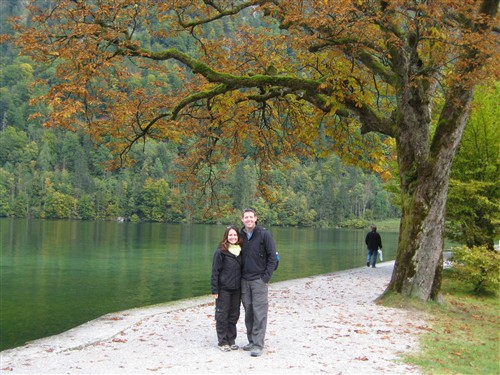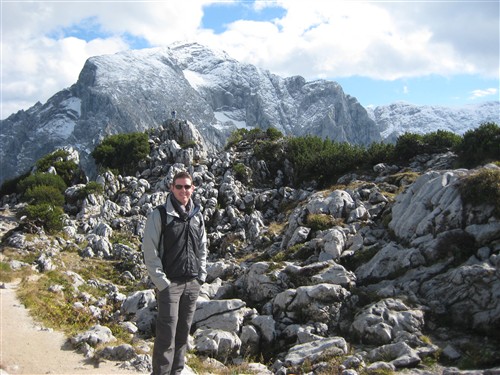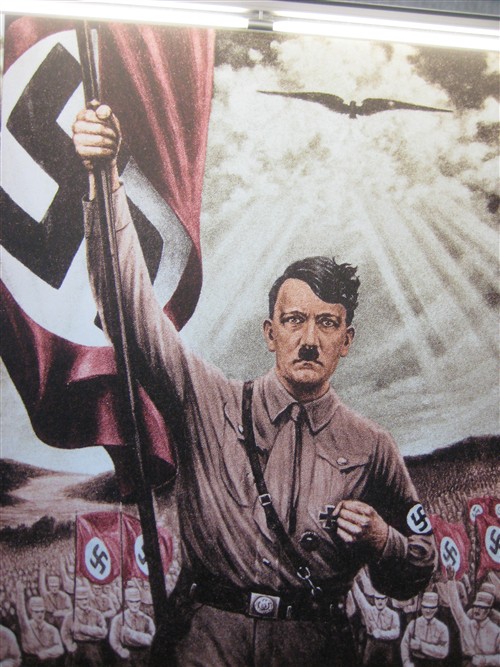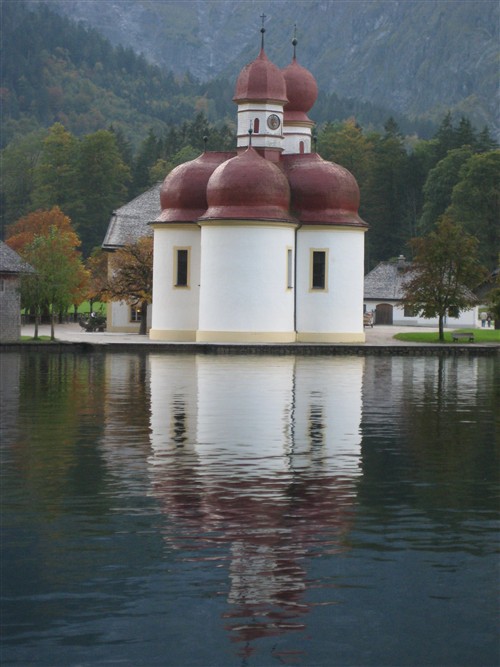Posted under Germany

The quaint resort town of Berchtesgaden in the German Bavarian Alps is a place of stunning natural beauty. The surrounding area, called Berchtesgadener Land, includes national park lands as well as a crystal clear glacial lake – the Konigssee.
Hitler fell in love with the area and bought a house there in the 1920s as did several of his key henchmen. The quiet mountain retreat of Obersalzberg eventually became the southern headquarters of Hitler’s government. For the Führer’s 50th birthday in 1939, he was presented with a lodge constructed atop Mount Kehlstein at a bewildering height of 1,834 meters. While most of the Nazi structures around Berchtesgaden were destroyed during the Allied invasion at the end of WWII, the lodge on mountaintop, referred to as both Kehlsteinhaus and the Eagle’s Nest, was left untouched.
 After Oktoberfest, we needed a place to dry out and relax for a few days. Berchtesgaden was only a couple of hours from Munich by train and sounded like the perfect escape from the urban chaos. In Munich, buildings grazed in cement pastures and raucous pedestrians filled the streets. As the train whisked us away, the cityscape gave way to magnificent forest-covered mountains, dusted with the colors of fall. Peaceful alpine villages dotted the sweeping green valleys and cows grazed in wide open spaces. Cheerful guesthouses were covered with flower boxes, each overflowing with bright-colored blooms. Even in the confines of the train, we began to breathe easier.
After Oktoberfest, we needed a place to dry out and relax for a few days. Berchtesgaden was only a couple of hours from Munich by train and sounded like the perfect escape from the urban chaos. In Munich, buildings grazed in cement pastures and raucous pedestrians filled the streets. As the train whisked us away, the cityscape gave way to magnificent forest-covered mountains, dusted with the colors of fall. Peaceful alpine villages dotted the sweeping green valleys and cows grazed in wide open spaces. Cheerful guesthouses were covered with flower boxes, each overflowing with bright-colored blooms. Even in the confines of the train, we began to breathe easier.
Our small hotel, Pension Greti, was located in one of the outlying villages near Berchtesgaden, a pleasant two-kilometer walk from the Konigssee. It was a charming place with cozy, country-style rooms – a perfect retreat on a chilly autumn night. The village seemed to consist of guesthouses and restaurants, each as lovely and welcoming as the next.
On our first morning in Berchtesgaden Land, the weather was cool and wet but the forecast was optimistic for the afternoon. After lingering over a fabulous breakfast in our hotel cellar, we ventured out to the bus stop to catch the bus to Dokumentation Obersalzberg, the former Nazi compound-turned-museum, documenting Hitler’s rise to power, the lives of the Nazi elite, propaganda, racial politics and, of course, the concentration camps. Throughout our travels, we have come to understand that the Germans are deeply ashamed of their dark past. After seeing the Holocaust Museum, Yad Vashem, in Jerusalem, we were curious to discover the perspective of exhibits in a German museum.
 Similar to Yad Vashem, the most interesting part of the presentation at Dokumentation Obersalzberg dealt not with the specific horrific acts perpetrated in the death camps but rather how a deranged maniac like Hitler came to power and influenced a nation toward genocide. The propaganda campaign, conceived and implemented by Dr. Joseph Goebbels, one of Hitler’s most loyal followers, was one of the most ingenious in history. While Yad Vashem approached the propaganda element by highlighting Hitler’s powerful rhetoric and anti-Semitic caricatures, Obersalzberg displayed more photographs of the Führer himself than we have ever seen – posters and other propaganda photos, staged to create and sell an image of Hitler as a man of the people, as a humanitarian, which slowly elevated the depraved lunatic to God-like status in the hearts and minds of his followers. The photos were both fascinating and haunting. I looked into those narrow dark eyes and saw evil but hindsight is twenty-twenty. Would I have seen it then? Would I have been able to see through the propaganda to the madman?
Similar to Yad Vashem, the most interesting part of the presentation at Dokumentation Obersalzberg dealt not with the specific horrific acts perpetrated in the death camps but rather how a deranged maniac like Hitler came to power and influenced a nation toward genocide. The propaganda campaign, conceived and implemented by Dr. Joseph Goebbels, one of Hitler’s most loyal followers, was one of the most ingenious in history. While Yad Vashem approached the propaganda element by highlighting Hitler’s powerful rhetoric and anti-Semitic caricatures, Obersalzberg displayed more photographs of the Führer himself than we have ever seen – posters and other propaganda photos, staged to create and sell an image of Hitler as a man of the people, as a humanitarian, which slowly elevated the depraved lunatic to God-like status in the hearts and minds of his followers. The photos were both fascinating and haunting. I looked into those narrow dark eyes and saw evil but hindsight is twenty-twenty. Would I have seen it then? Would I have been able to see through the propaganda to the madman?
Just as we’d finished absorbing the propaganda campaign, Aaron suddenly noticed that the sun was shining! We tried to focus on the next section of the museum but it was no use. We had to get outside! We turned in our audio guides and headed for the bus that would carry us to the top of Mount Kehlstein and the Eagle’s Nest. The bus climbed for 35 minutes – higher and higher and higher. It was dizzying! We marveled at the views of Berchtesgadener Land below, still shrouded in mist but illuminated from above. It was one of those beautiful moments when the passing clouds filter the sunlight into visible rays beaming down to earth, as if God is smiling from the Heavens.
The terrace of the Eagle’s Nest is leased out to a restaurant which donates profits to charity but the real draw of the lodge, besides its sinister past, is the view. Ascending the final 124m stretch in an elevator, we gasped at the vastness of our surroundings. We were at eye-level with snow-capped mountain peaks. Forest and field spread across the valleys like a green blanket while the Konigssee glittered in the sunlight. Climbing the craggy terrain behind the lodge to the viewpoint on the highest boulders of the peak, we were on top of the world.

It took three buses to get us down the mountain and over to the Konigssee to catch one of the last boats of the day. We were quite impressed to have made it and excited about the two-hour excursion. As the boat glided smoothly away from shore and into the horizon, we were treated to a view that rivaled Milford Sound in the fiord lands of New Zealand’s South Island with dramatically steep-sided mountains plunging out of the water. The sun, still visible over the western peaks, lit up the red, orange, and gold trees on the eastern mountainside and created a mirror image on the surface of the lake. It was magnanimous.
We were headed to St Bartholoma, a pretty onion-domed church on the edge of the lake. The Catholic pilgrimage church is named after St Bartholomew, the patron of alpine farmers and of milkmaids. Halfway there, the captain slipped the electric boat into neutral, picked up his Flugelhorn (similar to a trumpet), and rang out a series of notes which echoed off the sides of the mountain. It sounded as if another horn player was repeating his every note, the clarity of the echo was astounding.
 When we spotted St Bartholoma in the distance, we were disappointed to discover that the western mountains had already cast its postcard-perfect view in shadow. As we neared the dock, however, we saw that the soft light created a wintry pall, an ethereal glow, across the lakeshore. Stepping off the boat, we walked among the autumn trees and along the emerald green lake. The chapel doors were open and we found the interior modestly appointed with iconography and a simple altar. The chapel, which is accessible only by long hike or by boat, was quaint and lovely.
When we spotted St Bartholoma in the distance, we were disappointed to discover that the western mountains had already cast its postcard-perfect view in shadow. As we neared the dock, however, we saw that the soft light created a wintry pall, an ethereal glow, across the lakeshore. Stepping off the boat, we walked among the autumn trees and along the emerald green lake. The chapel doors were open and we found the interior modestly appointed with iconography and a simple altar. The chapel, which is accessible only by long hike or by boat, was quaint and lovely.
The sun had sunken completely behind the mountains as we made our way back across the lake. The ride was peaceful and we stepped onto the dock feeling relaxed. Since we’d been on buses for most of the day, the walk back to Pension Greti was a welcome opportunity to stretch our legs.
Our stay in Berchtesgadener Land was short – two gray days divided by a single blessed afternoon of sunshine during which we took in the historical highlights and breathtaking scenery. We enjoyed the infusion of German history into our alpine retreat but the best part of the German Bavarian Alps was the chance to escape the city, get lost and breathe in a few gulps of fresh mountain air before moving on to the next adventure.
Comments Off on Berchtesgaden
